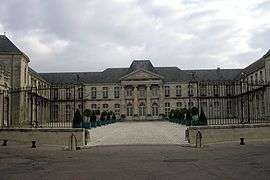Commercy
Commercy (French pronunciation: [kɔmɛʁsi]) is a commune in the Meuse department[2] in Grand Est in north-eastern France. The 18th-century Lorraine historian Nicolas Luton Durival (1713–1795) was born in Commercy.
Commercy | |
|---|---|
Subprefecture and commune | |
 The castle | |
 Coat of arms | |
Location of Commercy 
| |
 Commercy  Commercy | |
| Coordinates: 48°45′43″N 5°35′33″E | |
| Country | France |
| Region | Grand Est |
| Department | Meuse |
| Arrondissement | Commercy |
| Canton | Commercy |
| Intercommunality | Pays de Commercy |
| Government | |
| • Mayor | François Dosé |
| Area 1 | 35.37 km2 (13.66 sq mi) |
| Population (2017-01-01)[1] | 5,536 |
| • Density | 160/km2 (410/sq mi) |
| Time zone | UTC+01:00 (CET) |
| • Summer (DST) | UTC+02:00 (CEST) |
| INSEE/Postal code | 55122 /55200 |
| Elevation | 227–280 m (745–919 ft) (avg. 232 m or 761 ft) |
| 1 French Land Register data, which excludes lakes, ponds, glaciers > 1 km2 (0.386 sq mi or 247 acres) and river estuaries. | |
History
Commercy dates back to the 9th century, and at that time its lords were dependent on the bishop of Metz.[2] In 1544 it was besieged by Charles V in person. For some time the lordship was in the hands of Jean François Paul de Gondi, cardinal de Retz, who lived in the town for a number of years, and there composed his memoirs.[2] From him it was purchased by Charles IV, Duke of Lorraine.[2] In 1744 it became the residence of Stanisław Leszczyński, king of Poland, who spent a great deal of care on the embellishment of the town, castle and neighbourhood.[2]
Commercy is the home of the Madeleines referred to by Marcel Proust in A la Recherche du Temps Perdu.[3]
People from Commercy
- Nicolas Durival (1723–1795), historian
- Nicolas Alaidon (1738–1827), curé de Toul, emigrated during the French Revolution, author of the Journal d'un prêtre pendant la Révolution[4] (24 October 1738 – 1827).
- Henri Braconnot (1780–1855), chemist
- Henri Brocard (1845–1922), mathematician
- Georges Mangin (1873–1908), officer and explorer
- Benno Vigny (1889-1965), German-French scriptwriter and director
- Maurice Cloche (1907-1990), movie director
- Roger Lévy (1914-2006), Compagnon de la Libération
- Élisabeth de Miribel (1915-2005), Française libre
- Dominique Desseigne (1944), entrepreneur
- Pascal Vigneron (born 23 June 1963), organist, trumpeter, conductor, director of the Toul Bach Festival.
In fiction
Commercy is the key location for action in the 1964 film The Train although this did not use the town for filming purposes.
Twin towns
It is twinned with the German town of Hockenheim.
See also
References
- "Populations légales 2017". INSEE. Retrieved 6 January 2020.
- Chisholm, Hugh, ed. (1911). . Encyclopædia Britannica. 6 (11th ed.). Cambridge University Press. pp. 773–774.
- Proust, Marcel (1922). Du côté de chez Swann. À la recherche du temps perdu. Grasset and Gallimard.
- Journal d'un prêtre lorrain pendant la Révolution (1791-1799). Hachette. 1912..
External links
| Wikimedia Commons has media related to Commercy. |
- Office de Tourisme du Pays de Commercy (France)
- Office de Tourisme du Pays de Commercy (European Union)